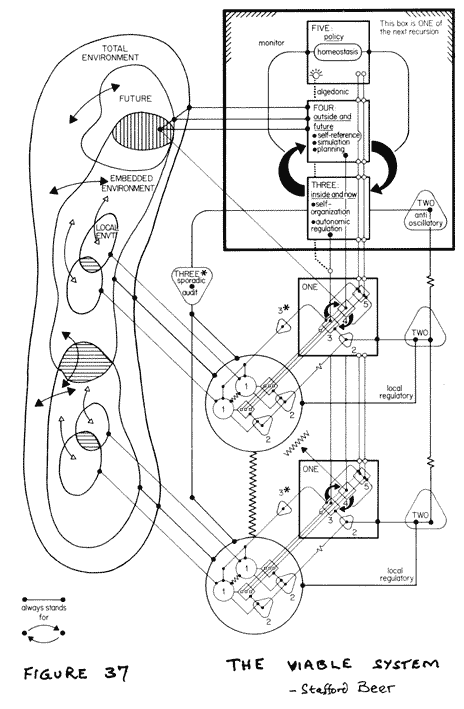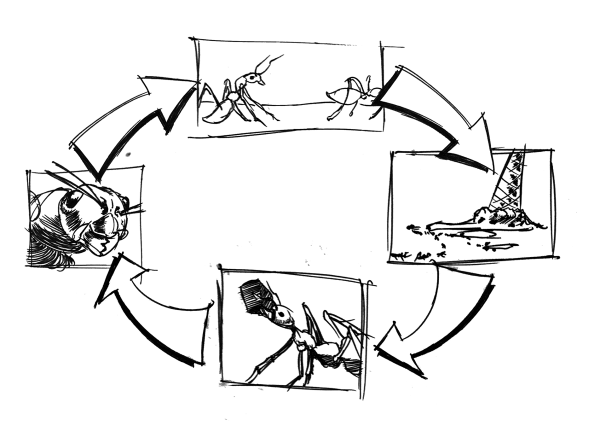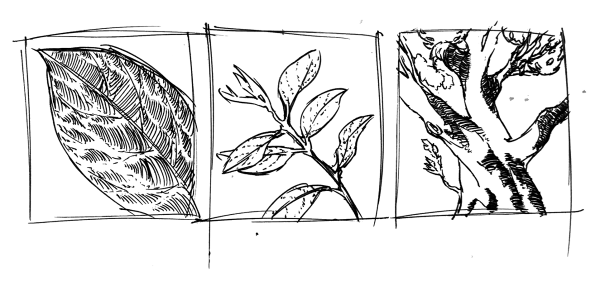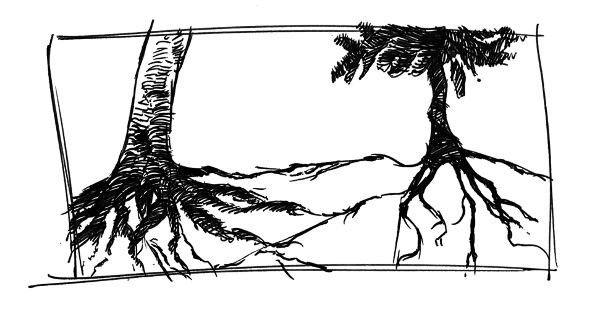Tools for Viable Organizing
Kyle Thompson
This article is also available in PDF form, suitable for printing. Organizing is difficult, and often exhausting work. It means bringing together strangers and facing a hostile environment along with them.
To help, this pamphlet introduces the structure for developing viable organizations. By viability, I mean the ability to adapt to and survive changes in the environment. The structure of viable organizations lets members share important information with those who need it, while filtering out noise. This ability to adapt and channel information allows for quick responses to danger or need, without losing sight of the big picture.
This structure has been used in many co-ops, as well as in the democratic revolution of 1970-1973 in Chile.
The Viable System Model
The Viable System Model (VSM) gives us this structure for building viable organizations. We can also use it to check if our organizations are set up to survive hostile environments. Any viable system should look like the VSM, so don’t be surprised if you are already doing a lot of what it suggests.
The VSM has six parts, called systems. These don’t need to be their own offices or committees, but every viable organization should somehow include all six functions.

- System 1 (Activity) - The parts that actually DO something and interact with the environment. They’re like the muscles and organs in your body. If you have a community garden or a soup kitchen, those are separate System 1s. They should be able to “do their own thing,” as long as they’re working.
- System 2 (Coordination) - The parts that connect the System 1s to each other. They make sure the System 1s operate in a stable way and aren’t in conflict with each other. A system 2 could be the person running from the soup kitchen to the garden to tell them they need carrots.
- System 3 (Coherence) - The part that looks at all the System 1s and figures out how they could work better. They take info from all the System 1s, and figure out how the big picture comes together. This system could be a working group figuring out how much food to pick from the garden, and how much needs to come from outside.
- System 3* (Auditing) - The part that checks in on System 1s to get extra information about how things are running. This can take the form of an audit, or simply members of the System 1 checking their own processes. Audits should only happen on request of the System 1, or if the System 1 breaks an “intervention rule.” Otherwise, the auditors of System 3* should leave it alone.
- System 4 (Strategy) - System four has two key tasks for creating strategy. Firstly, it looks out to the environment. For example, this could be a person looking online for the cheapest pasta. Secondly, it plans for the future using its own observations and info from System 3. For example, a weekly meeting on important news within the organization. It also filters information for general policy and sends it on to System 5.
- System 5 (Ethos) - The part that makes the “big decisions” affecting the whole organization. These decisions are about what kind of organization the membership wants to be. Normally, System 5 should have very little to do because the other systems handle daily concerns. But when a big question like “should our organization use guns?” comes up, System 5 needs to make a decision. Everyone in the organization should contribute to System 5. This usually means calling a general assembly and deciding what to do.

When all six systems work together, they keep internal conflict constructive. System 5 can’t know everything, and neither can any other system. They all adjust to disagreement by coordinating their different points of view.
The six systems will also let the organization adapt to its environment and thrive as best it can.
Getting Started
Viable systems can be very big, small, or somewhere in between. So when diagnosing your organization, you have to decide what scope you want to work at. Is it your garden, the whole community, the city, the country? Viable systems are recursive: Each one contains many others, like the way the pieces of a Russian Matryoshka doll fit together.

Every System 1 is its own VSM with all six parts of the model. If a whole system is really viable, then its members should be too, right? We can trust System 1s to “do their own thing” because they use all six systems. It lets them conduct daily activities and adapt to change as needed. Every time we go “down a level,” we pick a System 1 and look at how it contains all six systems in itself. There is always more organization to find as you zoom in or out. It’s like a spiral or a fractal picture.
The important thing is to pick a level to diagnose, and stick with it until you understand how it works. If your system is the kitchen, analyse the whole kitchen (not just one of its parts). You can get valuable insights so long as you do. After that, you can change your scope and diagnose again.
You could begin diagnosing your kitchen by noting what’s going on—food prep, cooking, serving, dishwashing, cleaning, meal planning, worker assignment; each of these is its own system. When you understand how the kitchen works, you could then diagnose dishwashing as its own system. How are dishes cleaned? How are they transported to the dishwashing station? And so on.
The Importance of Autonomy
It’s easy to look at the VSM and assume that control comes from the top down. In fact, sometimes it has to because cohesion becomes more important than autonomy. But the VSM doesn’t promote top-down dictatorships, because it sees why they are bad organizations.
When COVID broke out, the top health experts in the world needed to tell everyone to stay at home and use masks. Most of us followed those instructions because they made sense. But if a health expert came into our homes and told us when exactly to go to sleep, we’d tell them to take a hike. We understand the little details of our lives better than any expert could. We are the best judges of how to live our own lives, unless we’re being a danger to our society.
Almost everything is best decided autonomously because “the people on the ground” know what’s happening there. A well-designed system should maximize local autonomy. For example, the road rules tell everyone which side to drive on. As long as everyone stays on their side, System 2 is working well, and no one is bothered by on-coming traffic. No one tells every single driver what to do, they follow the rules autonomously and it all works out.
It’s the exceptions to the rule that need more coordination. The gardeners know best how to garden. But if they’re growing food no one wants to eat, it’s of no use to the organization. Then what to do with the wasted food? Maybe the garden can sell it to the grocery down the way? Is it okay for us to sell food? These kinds of questions can’t be answered by just gardening. The higher level systems need to keep the organization viable. This doesn’t mean having experts decide all the big questions. But it does mean everyone needs to be clear about what roles they’re playing, and when they switch.
Interventions
Sometimes System 3* needs to audit a System 1 when a System 1 breaks an “intervention rule.” Intervention rules are agreed by system 1 and 3 and set a breaking point that triggers the audit. Audits break the System 1’s autonomy, so should be taken very seriously.
Set intervention metrics
First of all, the System 1 should set metrics for itself. It doesn’t need to tell System 3 what they are. But it must decide what kinds of things it wants to do, and how much of each thing it should do. This could be something like, “How much water the garden needs, and when it needs watering?” Every time the garden doesn’t get watered, the metric gets worse; every time it does, it gets better. Once System 1 decides on the metrics, it needs to regularly pass along the numbers to System 3. Again, these metrics don’t need to be labeled. All that System 3 needs to know is if they’re going up or down.
Agree on the breaking point
System 1 and System 3 should agree on a breaking point where System 3* will intervene. For example: “If metric 1 is at less than 80% for 5 days, System 3 will send an auditor to see what’s going on and report back.”
Agree on a check-in (if needed)
System 1 knows best what metrics to set and how to meet them, but sometimes a check-in is required. Once System 3 sees what’s going on, they might come up with a solution or pass it along to System 4 to figure out. The higher-level systems then work out a plan with System 1, and autonomy is restored.
Major Pain Points
Out of the six systems, System 2 and System 4 are the most likely to be neglected or fail. This is because it’s not always obvious that they need doing. These pain points are also the areas most likely to come under attack from both outside and inside forces, so it’s important to nurture and strengthen them.

System 2—Thinking Horizontally
System 2s are the connections between the different System 1s. If they’re not relaying information between System 1s, things start to break down. If I’m focused on gardening in my System 1, it isn’t obvious that I need to see if the soup kitchen wants carrots. I’m already occupied with digging, weeding, planting, and watering. Besides, System 3 is there, so they can worry about the big picture, right?
No, we can’t leave this up to System 3, as it makes the whole organization move slower. System 3 is there to fine-tune and adjust. It’s not a micro-manager, and it will get overwhelmed if System 2 isn’t there to help. Move too slow, and your organization won’t be able to survive in a hostile environment. “Siloing” of System 1s is the first step on the way to disaster.
System 3 and 4—Thinking Vertically
One role of System 4 is looking out on the environment to plan for the future. The old story of the Ant and the Grasshopper warns us about one of the biggest problems with System 4: it’s easy to focus on today and forget tomorrow. Just keeping the day-to-day going is a lot of work, and setting aside time to plan ahead can be a bother. But in a hostile environment, the rule is “adapt or die.” One of our best ways to adapt as human beings is to take it all in and think of the future.
The other big role of System 4 is filtering information between System 3 and 5. It passes up important messages from System 3. It also takes instructions from System 5 and sends down “yellow alerts” or “red alerts” that tell everyone to listen up. The problem here is that System 3 focuses downwards to the System 1s, and filters out information.
If System 3 filters too much information, System 4 has nothing to pass on, and System 5 loses touch with the organization. Because System 5 doesn’t watch the environment, it also loses touch with reality!

Similarly, if System 4 is weak, it means that System 5 sets policy but no one listens. The System 1s will go on with their business, and System 3 will lose sight of what’s going on outside. Improve the little stuff while the big stuff is going wrong is a recipe for disaster. Unfortunately, this seems to be about as much as our political systems can manage today.
Keeping the System 3-4 link in balance is the biggest challenge an organization faces. System 4 should have a working model that combines its own view of the world, with operations info from System 3. The whole organization can’t plot the right path forward if the model is out of sync.
The good news is that by paying attention to System 2 and System 4, your organization will already be ahead. Most organizations fail here, so it is low hanging organizational fruit, ready to be picked.
Further Information
For more information on the VSM, check out the following links:
Printable PDF
This article is also available in PDF form, suitable for printing. The pamphlet was designed and illustrated by Matthew Borgatti.